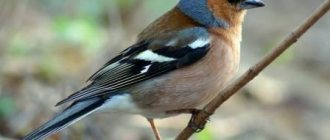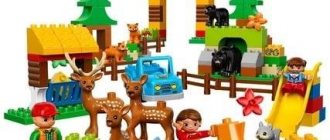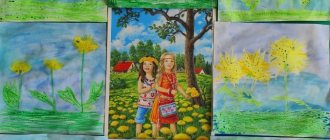Summary of GCD in the middle group on the topic: “Introduction to painting”
Summary of educational activities in the middle group on the topic: “Acquaintance with painting”
Author: Natalya Vladimirovna Lasavitskas, teacher of MBDOU kindergarten No. 15 “Rucheyok” in the city of Petrovsk, Saratov region. Description of the material: I offer you a summary of direct educational activities for children of the middle group (4-5 years old) on the topic “Introduction to painting.” This material will be useful for middle school teachers. This is a summary of an educational lesson aimed at cultivating interest in painting and developing a sense of beauty in middle school children. Summary of the direct educational activities of children in the middle group on the topic “Acquaintance with painting” Integration of educational areas: “Cognition”, “Socialization”, “Artistic creativity”, “Reading fiction”. Goal: To give children the concept of painting as a form of art. Objectives: Educational:
Talk about painting techniques: oil, watercolor, pastel.
Educational:
To give an idea of the technique of painting: it decorates the interior of buildings, affects the thoughts and feelings of viewers.
Speech:
Develop coherent speech, enrich children's vocabulary: landscape, still life, portrait, painting, oil paints, pastels.
Educational:
To form an aesthetic attitude towards painting.
Demonstration material: reproductions of paintings: V. Serov “Girl with Peaches”, I. Levitan “Golden Autumn”, P. Konchalovsky “Lilacs in a Basket”, a set of postcards, an easel. Handouts: A4 album sheets, paints and brushes according to the number of children. Methodological techniques: conversation-dialogue, examination of illustrations and conversations on them, physical exercise “I will color the whole world!”, productive activity of children, analysis, summing up, aiming to continue studying the material. Progress of GCD: Part I Educator. Guys, look, we have a new painting in our group - “Forest Glade” by an unknown artist. Do you like her? How? Why did the artist choose this particular corner of nature? (The artist liked bringing the children to the conclusion that the clearing was very beautiful, and he decided to share this beauty with us). Part II The teacher reads the riddle:
If you see - a river is drawn in the picture, Or a spruce and white frost, Or a garden and clouds, Or a snowy plain, Or a field and a hut - The picture is definitely called... LANDSCAPE!
(E. Uspensky)
Yes, our new painting is a landscape.
Look at another landscape – Levitan’s painting “Golden Autumn”. What kind of picture can we call a landscape? (children's answers - which can depict a forest, a river...) Guys, artists who paint landscapes are called landscape painters. If you are in a city, on the bank of a river, in a park, you see a person with an open sketchbook (that’s what they call a box where all the supplies an artist needs are stored), you have a happy opportunity to see how a landscape is born. Come and look - just don’t disturb the artist with questions and comments. Listen to my second riddle: If you see someone looking at us from a painting - Or a prince in an old cloak, Or a steeplejack in a robe, A pilot or a ballerina, Or Kolka - your neighbor - The painting is definitely called... PORTRAIT! (E. Uspensky)
What painting can we call a portrait?
(Children's answers.) Look, here is a portrait of a girl. It's called "Girl with Peaches." The girl's name is Vera. She was the daughter of the artist’s friend, Savva Ivanovich Mamontov. Do you like the girl? Did the artist like her? Why did he decide to draw her? (Bring the children to the idea that the artist does not paint everything he sees, but what is unusual and beautiful.) An artist who paints portraits is called a portrait painter. Most often, an artist gains experience as a portrait painter by depicting himself. A portrait where the author himself is depicted is called a self-portrait. The last riddle: If you see in the picture a Cup of coffee on the table, Or fruit drink in a large decanter, Or a rose in crystal, Or a bronze vase, Or a pear, or a cake, Or all the objects at once - Know that it is... STILL LIFE! (E. Uspensky)
What kind of painting can be considered a still life?
Take a closer look at this still life. It's called "Lilacs in a Basket". What impressed the artist with lilacs that he decided to depict them? (Children's answers.) How do you know that the artist thought exactly like that? Yes, he conveyed the beauty of lilac branches in such a way that we had the same feelings as the author. In France and Italy they gave the name to this genre as “dead nature”, and in Holland, Germany and England they say “quiet life, motionless life”. We, following the French, repeat: “still life.” Still life depicts existing, real objects that surround people. It is quite possible that both inanimate objects (kitchen utensils and household items) and “living nature” - fish, butterflies, birds, flowers - can be taken as a basis. In China of the Middle Ages, a genre called “flower-birds” was widespread. In Russia, still life appeared as an independent genre in the eighteenth century. The first paintings were naturalistic images—the artists presented things in the “nature” style. Usually the background was a wooden wall, on which books, watches and strange objects appeared as if they were real. Tell me, children, what do artists use to draw with? Yes, with a brush and paints. But paints come not only in watercolors, but also in oils. Take a closer look: you can see brush strokes in the picture – thin stripes. These are marks from brush hairs. This picture is painted with oil paints. And this picture seems to be transparent, it was painted in watercolors (show regular watercolors, a palette, tubes of oil paint). There is also pastel. You used it in class. And artists created entire paintings using both pastels and watercolors. Give children a set of postcards with reproductions of paintings by famous artists to look at, ask them to choose the one they like and determine its genre. Do you want to draw such a picture so that others also understand why you painted it? Go to the easels, where paper, paints and brushes are already waiting for you, and draw a portrait, landscape or still life - whatever you like best. (Remove all paintings and reproductions so that children do not copy). Part III Children with their works stand in a circle.
Look at the drawings of other children. - Guys, today you were artists. And we learned a lot about this form of art as painting. Where can you see real paintings? (In the museum) Do you want to go to the museum? We'll go there soon.
We recommend watching:
Abstract of the educational activity in the area of "Cognition" in the middle group "Let's help friends" Physical education and educational integrated educational activity in the middle group Abstract of the educational activity "Cognition" Mathematics in the middle group
Summary of educational activities on artistic creativity in the middle group according to the program “From birth to school”
Similar articles:
Summary of GCD in the middle group in artistic creativity
Lesson summary on artistic and productive activities in the middle group
Summary of GCD in the middle group in the educational field “Physical Education”
Summary of direct educational activities in the middle group
Summary of GCD in kindergarten on the topic: “Our skin”
Methodological features of viewing paintings in different age groups
Methods of teaching monologue speech
Storytelling from a picture
In the method of speech development, teaching storytelling from a picture (description and narration) has been developed in sufficient detail. Here the methodology is based on the classical heritage of Western and Russian pedagogy, later used in relation to work with preschool children by E. I. Tikheeva, E. A. Flerina, L. A. Penevskaya, E. I. Radina, M. M. Konina and others. All of them emphasized the great importance of pictures both for the general development of children and for the development of their speech.
In developing the skills to describe pictures and compose narrative stories, specially designed series of didactic paintings of different types (subject, plot, landscape, still life) are used.
Landscape paintings: A. Savrasov “The Rooks have Arrived”; I. Levitan “Golden Autumn”, “Spring. Big Water", "March"; K. Yuon “March Sun”; A. Kuindzhi “Birch Grove”; I. Shishkin “Morning in a pine forest”, “Pine forest”, “Forest cutting”; V. Vasnetsov “Alyonushka”; V. Polenov “Autumn in Abramtsevo”, “Golden Autumn”, etc.;
Still life: K. Petrov-Vodkin “Birch cherry in a glass”, “Glass and apple branch”; I. Mashkov “Rowan”, “Still Life with Watermelon”; P. Konchalovsky “Poppies”, “Lilacs at the Window”.
When selecting paintings for storytelling, a number of requirements are imposed on them:
— the content of the picture should be interesting, understandable, and foster a positive attitude towards the environment;
- the picture must be highly artistic;
— images of characters, animals and other objects must be realistic; a conventional formalistic image is not always perceived by children;
— you should pay attention to the accessibility of not only the content, but also the image. There should be no pictures with an excessive accumulation of details, otherwise children will be distracted from the main thing. Strong reduction and obscuring of objects makes them unrecognizable. Excessive shading, sketchiness, and incompleteness of the drawing should be avoided.
One of the techniques that prepares children to tell a story based on a picture is looking at and talking about its content.
Children do not know how to look at pictures, cannot always establish relationships between characters, and sometimes do not understand how objects are depicted. Therefore, it is necessary to teach them to look and see the object or plot in the picture, to develop observation skills.
Methodological features of viewing paintings in different age groups
The role of pictures for young children is primarily to consolidate and deepen children's experience and only to a small extent to expand it.
Examination begins with bringing in the picture and silently contemplating it. But since the kids cannot silently look at the picture, the teacher maintains the conversation, draws their attention to the object or character and gradually develops the conversation. The main methodological technique here is questions. With a question, the teacher immediately identifies the central image (Who do you see in the picture?), then other objects, subjects, and their qualities are considered. This is how the perception of the picture proceeds consistently, bright details are highlighted, the vocabulary is activated, and dialogue develops. In addition to questions, explanations and game techniques are used (children are asked to mentally put themselves in the place of the child who is drawn, give a name to the character; the game “Who will see more?”). The sequence of questions ensures a holistic perception of the picture, and game techniques maintain interest in it. Such an examination of the picture comes close to a conversation between a teacher and children.
A more complex type of viewing is a conversation based on a picture. It differs from the previous lesson in greater focus, systematicity of questions, consistency of consideration and the mandatory participation of all children.
Here, in addition to questions, the teacher’s generalization, prompting of the right word, and children’s repetition of individual words and sentences are used. The conversation ends with a summary story. In such a conversation, choral responses predominate. It is difficult for children to remain silent and maintain attention to the picture while giving individual answers. Their speech reactions are slow.
When examining pictures, the teacher takes into account the interests of the children and their psychological characteristics. So, if the picture is dynamic (“Cat with kittens”), it is better to first of all draw children’s attention to the dynamics and actions of the characters (a playing kitten). If the picture is bright, colorful, or it depicts something that catches your eye, that’s where you should start looking (“Chickens” - a bright rooster). It is not recommended to show the picture to children in advance (before the lesson), since the novelty of perception will be lost and interest in the picture will quickly disappear. Independent perception in children is not sufficiently developed.
In middle preschool age, more complex subject and plot pictures are recommended for viewing (“Gifts for Mom on March 8th”, “Dear Guests”, “On the River”, “Visiting Grandma”)1. Some of them are given only for viewing, others - for viewing and subsequent telling.
Conversations based on pictures become more complex, children learn to see not only the main thing, but also the details. In the painting “Dog with Puppies,” for example, attention is drawn not only to the dog and its puppies, but also to the sparrows and their actions. During examination, you can offer to describe one of the objects, drawing on children's experience. So, in a conversation about the painting “On the River”, you need to give the opportunity to admire the river, the blue sky, the steamboat that is carrying many passengers, and then move on to looking at those on the shore, ask if anyone has ridden a boat or sailed on a steamship. In conclusion, you can read a story on this topic.
In older preschool age, when talking about pictures, special attention is paid to a more detailed examination due to the greater complexity of the content. The picture can be viewed in parts. First, the main thing, then the details that children should notice for themselves. For subsequent descriptions, you should pay attention to the interior, background, landscape. It is also important that the child express in figurative words his personal attitude towards the perceived landscape, river, forest. In this regard, you can choose epithets and comparisons with your children.
E. P. Korotkova recommends using questions that develop imagination and creativity. So, when looking at the painting “Autumn Day,” talking about two boys going to school, you can ask: “What do you think they can talk about?” Based on the painting “Winter Fun,” to activate the imagination, you can ask the following question: “If you come closer to the place where the kids are having fun, what can you hear?” The events that children talk about will be associated with sound impressions: you can hear the snow crunching in the cold; You can hear children laughing and cheerful screams. Children then incorporate these facts into their stories.
The invitation to ask questions themselves will increase children's activity. For example, during a lesson on the painting “Hedgehogs,” a riddle is asked about a hedgehog. Children are reminded that they already know a lot about hedgehogs (what they eat, how they curl up into a ball, how they snort angrily). Then they are asked to think about what else they would like to know about hedgehogs and ask a question. Children may want to know how hedgehogs make burrows, what hedgehogs are born like, and whether they grow quickly. Next, they look at a picture that helps answer these questions. With his explanations, the teacher clarifies the children’s ideas. At the end of the conversation, it is legitimate to ask: “What new did you learn from the conversation?” (Example of E.P. Korotkova.)
To activate speech and thinking, such techniques as asking children to think (“What else would you like to know?”), indicating in what form to carry it out (“Ask questions”), leading children to a generalization (“What new things have you learned?”) were used ?).
The development of creativity is facilitated by the technique of children coming up with a title for a picture, discussing it, choosing the most successful one, and comparing it with the real title.
In the methodology of speech development, there are several types of children's stories based on the picture.
1. Description of object paintings is a coherent, sequential description of the objects or animals depicted in the picture, their qualities, properties, actions, and way of life.
2. Description of the subject picture is a description of the situation depicted in the picture, which does not go beyond the content of the picture. Most often this is a statement of the contamination type (both a description and a plot are given).
3. A story based on a sequential plot of a series of paintings. The child talks about the content of each plot picture from the series, linking them into one story.
4. Narrative story based on the plot picture. The child comes up with a beginning and an end to the episode depicted in the picture. He is required not only to comprehend the content of the picture and convey it in words, but also to create preceding and subsequent events with the help of his imagination.
5. Description of a landscape painting and still life.
Summary of a lesson on speech development “Journey through fairy tales” in the middle group
Irina Duklis
Summary of a lesson on speech development “Journey through Fairy Tales” in the middle group
Summary of a lesson on speech development in the middle group “ Journey through Fairy Tales ”
Goal: Consolidating knowledge about Russian folk tales - names , characters, their dialogues, sequence in fairy tales .
• Learn to recognize Russian folk tales ;
• Develop memory , attention, logic.
• Develop speech activity through the use of small folklore forms, develop interest in artistic expression and children's pictures.
• Develop a positive attitude toward participation in the lesson , friendly relationships, and cooperation skills.
• Foster mutual assistance, friendliness, caring attitude towards animals, love for loved ones and nature.
Methodological techniques: surprise moment, conversation, answers to questions, game, encouragement.
Preliminary work: reading fairy tales , looking at illustrations, playing games based on fairy tales , guessing riddles.
Equipment and materials: pictures with illustrations, selection of riddles, selection of objects from fairy tales , chest, bun, letter, stickers, bell





